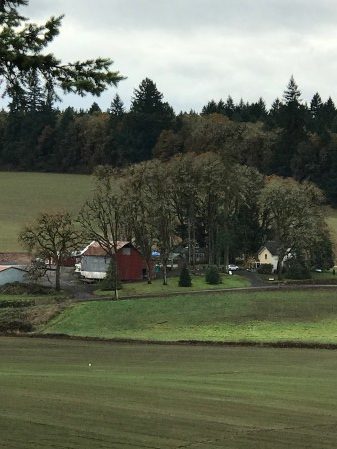Ghost Hill Cellars Pinot Noir Blanc – Willamette Valley Gem

This is the latest chapter in our ongoing series of posts about wines and wine makers that we feature on our Online Wine Store. Our Topochines Vino wine store focuses on small-production wines from family wineries in the United States and Europe. This chapter is dedicated to one of our newer winery partners, Ghost Hill Cellars in Oregon’s Willamette Valley, whose 2013 and 2014 Pinot Noir Blanc are sold on our site.
Most of the world’s champagne is made from the red Pinot Noir grape. After the Pinot Noir grapes are pressed, the extracted juice is removed before the dark skins contribute any color. What emerges from this process is a clear liquid that will, after a couple of fermentations, become champagne. What many people do not know is that a still, white wine can also be produced from Pinot Noir Grapes; this wine is called Pinot Noir Blanc, or white Pinot Noir. We encountered this wine recently during a trip to find unique wines for our Topochines Vino wine store. We were so impressed with the wine that we snapped up several cases and the 2013 and 2014 vintages are now available here: Ghost Hill Pinot Noir Blanc.
Just before Thanksgiving, we spent nearly a week in Oregon’s Willamette Valley crisscrossing the Valley from one A.V.A. to another. One of our favorite stops was the intriguingly named Ghost Hill in the Yamhill-Carlton District. According to legend, in the late 1890’s a miner was traveling from Southern Oregon to sell his gold in Portland. He made the fateful decision to stop for the night and set up camp at the top of what is now known as Ghost Hill. During the night, so the story goes, the miner was robbed and killed, his horse mortally injured, and his hard-earned gold stolen. To this day, the miner is said to wander the hill looking for his stolen gold and to right the wrongs that befell him that night. Hence the name Ghost Hill.

Not hard to imagine a ghost on that hill
While the miner may be still searching for his gold, the Bayliss family has struck gold of its own on this property – wine gold, that is. In total, the Bayliss family owns 234 acres of farmland, a true “Century” farm – meaning it has been owned continuously by the same family for over 100 years. In the case of the Bayliss clan, they are on their fifth generation working this land. For most of the 20th Century, the Ghost Hill land was dedicated to sheep and cattle, hay, and other crops. In 1999, Mike Bayliss and his wife Dendra decided to plant Pinot Noir on a portion of the property and today they farm a 16-acre parcel planted 100% to Pinot Noir. Their Ghost Hill Cellars label produces several different wines from these grapes – the above-mentioned Pinot Noir Blanc, a rosé of Pinot Noir, and two separate Pinot Noir offerings.
We did our tasting in the cozy Ghost Hill tasting room, with owners Mike and Dendra pouring the wines and telling us more about each of the wines. Mike and his son Michael built the wooden Ghost Hill tasting room building by hand,
inspired by prospector shacks of the 1850s. The building features a sliding barn door,
reclaimed windows from the nearby Trappist Abbey Church, and a counter made from the former altar floor.

Ghost Hill Cellars tasting room
Mike and Dendra live on the Ghost Hill estate in the same farmhouse where Mike was born 70 years ago. He and Dendra have been married for 50 years and they are true partners managing this large farm. As Ghost Hill only makes wine from Pinot Noir, we made our way through their portfolio, starting with the whites, moving to the “pink,” and on to the red.
We started our tasting with the 2013 Ghost Hill Cellars Pinot Noir Blanc, and tasted it side-by-side with the same wine from the 2014 vintage.

We enjoyed both wines immensely; they were crisp and refreshing with aromatics of pear and spice and, on the palate, apple, pear and honey. Our next wine was the 2015 Ghost Hill Cellars Rosé of Pinot Noir.

Like the white Pinot Noir, the Rosé was crisp and refreshing with a nice balance of fruit and acidity. Strawberry and citrus on the nose give way on the palate to a luscious blend of watermelon, citrus fruit and strawberry.
Our final two wines were (red) Pinot Noir offerings – the 2012 Ghost Hill Cellars Prospector’s Reserve and the 2013 Bayliss-Bower Pinot Noir. Both of these wines are blends of four different Pinot Noir clones from Ghost Hill’s estate vineyards. Both wines are classic expressions of Willamette Valley Pinot Noir, although the Prospector’s Reserve (priced slightly higher than the Bayliss-Bower) is a bit more dense and full-bodied. Either wine would make for a great pairing with Christmas dinner.
For us, the “trifecta” of wine tasting occurs when we encounter (1) wines that we love, (2) in a magical location, (3) made by people that we like and admire. Ghost Hill Cellars hit the trifecta for us.
John & Irene Ingersoll
December 17, 2017